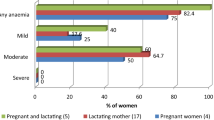Abstract
The chapter presents a comparative analysis of mortality status, maternal health, delivery care, child immunization, contraception and contraceptive use, as well as nutritional status among children and reproductive health aspects in the state of Telangana. It is found that the gaps between Muslims and the national averages on majority of the human development indicators have narrowed down. In the undivided Andhra Pradesh, Muslim children reported a low Under-5 mortality rate (U5MR) as compared with the state average. In Telangana state, 28 per cent of Muslim children are underweight as compared to 29 per cent among Hindus. Among Muslims, about 24 per cent of the children of under-5 are stunted and 13 per cent are severely stunted. The maternal and child health indicators show that Muslim minorities are on a par with urban averages in the State in accessing various health services. Muslim women availed a high rate of postnatal care than SCs and other religious groups. Higher utilization of six types of ANC tests by pregnant women of the Muslim community and higher child immunization which was preferred from the government sector among the community indicates better health-seeking behaviour of Muslim, on a par with other religious and caste groups.
Access this chapter
Tax calculation will be finalised at checkout
Purchases are for personal use only
Similar content being viewed by others
Notes
- 1.
As per Census-2011 data, the religion-wise population in Telangana State was 85.1% Hindu, 12.7% Muslim, 1.3% Christian, 1.0% others.
References
Balasubramanian, K. (1999). Pace of fertility decline and prospects for population stabilization in Andhra Pradesh. Demographic India, 28(1), 23–46.
Balasubramanian, K., & Satya Sekhar, P. (2004). Sample survey of eligible couples and child immunization in Andhra Pradesh, (Mimeo). Hyderabad: Indian Institute of Health and Family Welfare.
Basant, R. (2007). Social, economic and educational conditions of Indian Muslims: Symposium on Sachar committee report. Economic and Political Weekly, 42(10), 828–832.
Bhalotra, S., Valente, C., & Van Soest, A. (2010). The puzzle of Muslim advantage in child survival in India. Journal of Health Economics, 29, 191–204.
Francis, Z. A. J., & Mari Bhat, P. N. (2005). Role of religion in fertility decline: The case of Indian Muslims. Economic and Political Weekly, 40(5), 385–402.
Census of India 2011: C-1 Population by Religious Community, www.censusindfia.gov.in/2011census/C-01.html
Geruso, M., & Speares, D. (2014). Sanitation and health externalities: Resolving the Muslim mortality paradox. Retrieved on November 23, 2015, from www.usid.ac.in/~PU/seminar/dean.pdf.
IHDR. (2011). India human development report: Towards social inclusion, Institute of Applied Manpower Research (IAMR), Planning Commission, Government of India, New Delhi. www.Im4change.org/docs/340IHDR_Summary.pdf.
Mishra. (2004). Muslims and non-Muslim differentials in fertility and family planning in India, East West Centre working Paper, Population Health Series, No. 112.
National Institute of Public Cooperation and Child Development (2015), An Analysis of Levels and Trends in Maternal Health and Maternal Mortality Ratio in India – A Report, NIPCCD.
Office of the Registrar General. (2014). Sample Registration System. New Delhi: Office of the Registrar General of India.
Rajan, S. I. (2005). District level fertility estimates for Hindus and Muslims. Economic and Political Weekly, 40(5), 438.
Ram, M. S., Satya Sekhar, P., Chatterjee, N., & Kundu, N. K. (2012). Evidence to guide the development of social and behavioural change communication strategy for maternal and child health and nutrition in Andhra Pradesh (p. 2012). Government of Andhra Pradesh, UNICEF: Department of Health and Family Welfare.
Rathi, A. (2016). A new explanation for the mysterious child mortality puzzle among Muslims: Open defecation, May 31, 2014, <Scroll.in> downloaded on July 23, 2016.
Reynolds, H. W., Wong, E. L., & Tucker, H. (2006). Adolescents’ use of maternal and child health services in developing countries. International Family Planning Perspectives, 32(1), 6–16.
Sekhar, S. P., Umadevi, V., Rajeswari, N. V., & Sita Rama Rao, C. H. V. S. (2007). Baseline survey on reproductive and child health (RCH-II) in Andhra Pradesh—key findings, (Mimeo), Indian Institute of Health and Family Welfare, Hyderabad.
Shaila, P. (2014). Millennium development goals: Status of Muslims in India. Islam and Muslim Societies: A Social Science Journal, 7(2), 84–103.
Shariff, A. (1995). Socio-economic and demographic differentials between Hindus and Muslims in India. Economic and Political Weekly, 30(46), 2947–2953.
The Eastern Post. (2014). The Kundu Committee Report: Findings and Suggestions, Wednesday, 17th December. Retrieved on December 30, 2016, from https://www.theeasternpost.org/more_cover.php?id=185.
United Nations. (2015). India and MDGs: Towards a sustainable future for all. https://www.unescap.org.
Acknowledgements
I sincerely thank the referees for suggestions and express my thanks to Chairman, Commission of Enquiry on Socio-Economic & Educational Conditions of Muslims, Government of Telangana, for giving me the opportunity to write this chapter. I owe a debt of gratitude to Smt Vakati Karuna, IAS, Director (FAC), Indian Institute of Health and Family Welfare (IHFW), Hyderabad, for her encouragement. Thanks also to Professor S. Galab, Director, Centre for Economic and Social Studies, Hyderabad, for his encouragement and valuable suggestions.
Author information
Authors and Affiliations
Corresponding author
Editor information
Editors and Affiliations
Rights and permissions
Copyright information
© 2021 The Author(s), under exclusive license to Springer Nature Singapore Pte Ltd.
About this chapter
Cite this chapter
Satya Sekhar, P. (2021). Health and Nutrition: Malnutrition and Anaemia. In: Sudhir, G., Bari, M.A., Khan, A.U., Shaban, A. (eds) Muslims in Telangana. Dynamics of Asian Development. Springer, Singapore. https://doi.org/10.1007/978-981-33-6530-8_8
Download citation
DOI: https://doi.org/10.1007/978-981-33-6530-8_8
Published:
Publisher Name: Springer, Singapore
Print ISBN: 978-981-33-6529-2
Online ISBN: 978-981-33-6530-8
eBook Packages: Religion and PhilosophyPhilosophy and Religion (R0)




